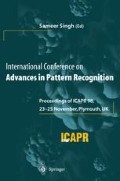Abstract
Segmentation is the process of recognizing an object of interest in a picture. Thresholding is not an appropriate method of segmentation if there is some nonuniform shading in the picture or if what distinguishes the object of interest is not the exact values assigned to the individual pixels but rather some textural property. In such cases one can usefully apply fuzzy segmentation. We call a sequence of pixels in which consecutive pixels are adjacent a chain, and a pair of adjacent pixels a link. In fuzzy segmentation, the strength of any link is automatically defined based on statistical properties of the links within regions identified by the user as belonging to the object of interest. The strength of a chain is the strength of its weakest link. The fuzzy connectedness between any pair of pixels is the strength of the strongest chain between them. The fuzzy object containing a given pixel at a particular threshold is the set of all those pixels whose fuzzy connectedness to the given one exceeds or equals the threshold. A potentially time-consuming step in fuzzy segmentation is the calculation of the fuzzy connectedness of all other pixels to the given one. Previously this was done by a dynamic programming technique. We investigate the usefulness of replacing this by either of two greedy algorithms that have asymptotically better worst-case running times. We experimentally demonstrate that, even on quite small pictures, the greedy algorithms are many times faster than the dynamic programming technique.
Access this chapter
Tax calculation will be finalised at checkout
Purchases are for personal use only
Preview
Unable to display preview. Download preview PDF.
References
T.H. Cormen, C.E. Leiserson, and R.L. Rivest. Introduction to Algorithms. MIT Press, Cambridge, MA, 1990.
F. Harary. Graph Theory. Addison-Wesley Publ. Co., Reading, MA, 1969.
G.T. Herman. Geometry of Digital Spaces. Birkhauser Boston, Cambridge, MA, 1998.
T.N. Jones and D.N. Metaxas. Segmentation using deformable models with affinity-based localization. In J. Troccaz, E. Grimson, and R. Mösges, editors, Proc. CVRMed/MRCAS’97, volume 1205 of Lecture Notes in Computer Science, pages 53–62. Springer-Verlag, Berlin, 1997.
A. Kandel. Fuzzy Techniques in Pattern Recognition. John Wiley & Sons, New York, 1982.
S.K. Pal and D.K.D. Majumder. Fuzzy Mathematical Approach to Pattern Recognition. Wiley Eastern Ltd., New Delhi, 1986.
K. Preston, Jr. Multidimensional logical transforms. IEEE Trans. Pattern Anal. Mach. Intell, 5:539–554, 1983.
A. Rosenfeld. Fuzzy digital topology. Inform, and Control, 40:76–87, 1979.
J.K. Udupa, D. Odhner, S. Samarasekera, R. Goncalves, K. Iyer, K. Venugopal, and S. Furuie. 3DVIEWNIX: An open, transportable, multidimensional, multimodality, multiparametric imaging software system. Proc. SPIE, 2164:58–73, 1994.
J.K. Udupa and S. Samarasekera. Fuzzy connectedness and object definition: Theory, algorithms and applications in image segmentation. Graph. Models Image Proc, 58:246–261, 1996.
J.K. Udupa, L. Wei, S. Samarasekera, Y. Miki, M.A. van Buchem, and R.I. Grossman. Multiple sclerosis lesion quantification using fuzzy-connectedness principles. IEEE Trans. Med. Imag.,16:598–609, 1997.
Author information
Authors and Affiliations
Editor information
Editors and Affiliations
Rights and permissions
Copyright information
© 1999 Springer-Verlag London Limited
About this paper
Cite this paper
Carvalho, B.M., Gau, C.J., Herman, G.T., Kong, T.Y. (1999). Algorithms for Fuzzy Segmentation. In: Singh, S. (eds) International Conference on Advances in Pattern Recognition. Springer, London. https://doi.org/10.1007/978-1-4471-0833-7_16
Download citation
DOI: https://doi.org/10.1007/978-1-4471-0833-7_16
Publisher Name: Springer, London
Print ISBN: 978-1-4471-1214-3
Online ISBN: 978-1-4471-0833-7
eBook Packages: Springer Book Archive

